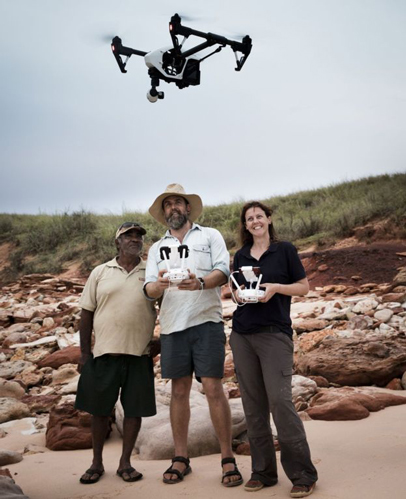Dinosaur Tracks Getting Mapped in Western Australia
The extensive dinosaur tracks that can be found along the coast of western Australia are getting plenty of tender loving care as a team of scientists led by researchers from the University of Queensland attempt to map and produce three-dimensional images of all these ancient trace fossils. Researchers are setting out to map the dinosaur heritage of western Australia.
The fossilised footprints, permitting palaeontologists to go “walking with dinosaurs” are found near to the town of Broome (Western Australia) and north along the coast of the Dampier Peninsula, a relatively remote area, some nine hundred kilometres south-west of the city of Darwin. The dinosaur trackways were granted National Heritage status, after a successful lobbying campaign, back in 2011, yet scientists have not been able to map all the tracks and prints preserved in this area, famous for its high tides.
Australia’s Dinosaur Heritage
The tides are part of the problem, this is a macro-tidal environment with tidal surges in excess of ten metres frequently occurring. A number of prints are only exposed for a few hours a day whilst other tracks are only exposed on extremely low tides that occur just a couple of times per year.
A Jumble of Sauropod Prints Exposed on the Shoreline
Picture credit: Dr Steve Salisbury
The Dinosaurs of Western Australia
Back in the spring of 2014, Everything Dinosaur reported in this blog on the calls for more research to be done on this unique fossil assemblage. The hundreds of tracks represent many kinds of Early Cretaceous dinosaurs – theropods, stegosaurs, ornithopods and sauropods. Some of the footprints believed to have been made by sauropods (long-necked, large-bodied, long-tailed giants) measure over 1.5 metres in diameter, making them some of the largest dinosaur trace fossils known to science.
To read this earlier article: Call for More Work to be Done on Western Australia’s Dinosaur Tracks.
Although, some of the tracks, especially the three-toed (tridactyl) prints are very obvious, the only way the extent of the tracks can be fully appreciated is by viewing them from the air. Drones and light aircraft have been employed by the researchers to photograph and plot the dinosaur footprints. In addition, some of the drones and aircraft have been kitted out with LiDAR equipment, which is helping to create a three-dimensional map of the terrain. LiDAR (light detection and ranging), uses pulsating laser lights to plot features in the landscape in combination with satellite positioning technology to make highly accurate maps of the tracks.
A Variety of Research Methods Employed
More mundane research methods are also being employed such as photographing individual prints and making silicon rubber moulds. All this research is very worthwhile as some of the prints are being rapidly eroded away by the action of the sea and tides.
Drones are Used to Plot the Dinosaur’s Movements
Picture credit: Damian Kelly
Early Cretaceous Dinosaur Tracks
It is believed that these tracks were made in the Early Cretaceous, around 130 million years ago (Barremian faunal stage of the Cretaceous), these fossils are something like twenty million years older than the dinosaur fossils associated with Queensland such as the titanosaurs Diamantinasaurus and Wintonotitan.
Commenting on the mapping project, Dr Steve Salisbury (University of Queensland) stated:
“These tracks are at least 15 to 20 million years older than the majority of dinosaur fossils that have been found at sites in eastern Australia. We can, to a degree, accurately reconstruct scenes that happened 130 million years ago. That’s not imagination, that’s piecing it together from the evidence found in the rocks. It’s a powerful way of bringing these ancient worlds back to life.”
We at Everything Dinosaur wish the research team every success with their colossal mapping effort. They are helping to preserve and to secure data from a very important Early Cretaceous fossil site.
CollectA have produced a number of models of dinosaurs that once roamed Gondwana, including titanosaurs, stegosaurs and theropods: CollectA Deluxe Prehistoric World Figures.







